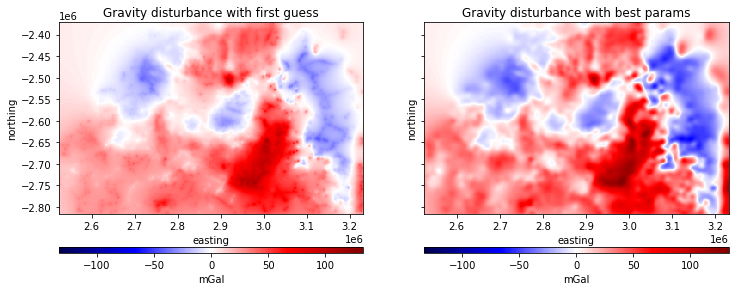Estimating damping and depth parameters
Contents
Estimating damping and depth parameters¶
When interpolating gravity and magnetic data through the
Equivalent Sources technique we need to choose values for some
parameters, like the depth at which the sources will be located or the
amount of damping that should be applied.
The choice of these hyperparameters can significantly affect the accuracy of the predictions. One way to make this choice could be a visual inspection of the predictions, but that could be tedious and non-objective. Instead, we could estimate these hyperparameters by evaluating the performance of the equivalent sources with different values for each hyperparameter through a cross validation.
See also
Evaluating the performance of EquivalentSources through cross
validation is very similar to how we do it for any verde gridder.
Refer to Verde’s
Evaluating Performance
and Model Selection
for further details.
Cross-validating equivalent sources¶
Lets start by loading some sample gravity data:
import ensaio
import pandas as pd
fname = ensaio.fetch_bushveld_gravity(version=1)
data = pd.read_csv(fname)
data
| longitude | latitude | height_sea_level_m | height_geometric_m | gravity_mgal | gravity_disturbance_mgal | gravity_bouguer_mgal | |
|---|---|---|---|---|---|---|---|
| 0 | 25.01500 | -26.26334 | 1230.2 | 1257.474535 | 978681.38 | 25.081592 | -113.259165 |
| 1 | 25.01932 | -26.38713 | 1297.0 | 1324.574150 | 978669.02 | 24.538158 | -122.662101 |
| 2 | 25.02499 | -26.39667 | 1304.8 | 1332.401322 | 978669.28 | 26.526960 | -121.339321 |
| 3 | 25.04500 | -26.07668 | 1165.2 | 1192.107148 | 978681.08 | 17.954814 | -113.817543 |
| 4 | 25.07668 | -26.35001 | 1262.5 | 1289.971792 | 978665.19 | 12.700307 | -130.460126 |
| ... | ... | ... | ... | ... | ... | ... | ... |
| 3872 | 31.51500 | -23.86333 | 300.5 | 312.710241 | 978776.85 | -4.783965 | -39.543608 |
| 3873 | 31.52499 | -23.30000 | 280.7 | 292.686630 | 978798.55 | 48.012766 | 16.602026 |
| 3874 | 31.54832 | -23.19333 | 245.7 | 257.592670 | 978803.55 | 49.161771 | 22.456674 |
| 3875 | 31.57333 | -23.84833 | 226.8 | 239.199065 | 978808.44 | 5.116904 | -20.419870 |
| 3876 | 31.37500 | -23.00000 | 285.6 | 297.165672 | 978734.77 | 5.186926 | -25.922627 |
3877 rows × 7 columns
And project their coordinates using a Mercator projection:
import pyproj
projection = pyproj.Proj(proj="merc", lat_ts=data.latitude.values.mean())
easting, northing = projection(data.longitude.values, data.latitude.values)
coordinates = (easting, northing, data.height_geometric_m.values)
Lets fit the gravity disturbance using equivalent sources and a first guess for
the depth and damping parameters.
import harmonica as hm
eqs_first_guess = hm.EquivalentSources(depth=1e3, damping=1)
eqs_first_guess.fit(coordinates, data.gravity_disturbance_mgal)
EquivalentSources(damping=1, depth=1000.0)In a Jupyter environment, please rerun this cell to show the HTML representation or trust the notebook.
On GitHub, the HTML representation is unable to render, please try loading this page with nbviewer.org.
EquivalentSources(damping=1, depth=1000.0)
We can use a cross-validation to evaluate how well these equivalent sources
can accurately predict the values of the field on unobserved locations.
We will use verde.cross_val_score and then we will compute the mean
value of the score obtained after each cross validation.
import numpy as np
import verde as vd
score_first_guess = np.mean(
vd.cross_val_score(
eqs_first_guess,
coordinates,
data.gravity_disturbance_mgal,
)
)
score_first_guess
0.8027851941632994
The resulting score corresponds to the R^2. It represents how well the equivalent sources can reproduce the variation of our data. As closer it gets to one, the better the quality of the predictions.
Estimating hyperparameters¶
We saw that we can evaluate the performance of some equivalent sources with
some values for the depth and damping parameters through cross
validation.
Now, lets use it to estimate a set of hyperparameters that produce more
accurate predictions.
To do so we are going to apply a simple grid search over the depth,
damping space, apply cross validation for each pair of values and keeping
track of their score.
Lets start by defining some possible values of damping and depth to
explore:
dampings = [0.01, 0.1, 1, 10,]
depths = [5e3, 10e3, 20e3, 50e3]
Note
The actual value of the damping is not significant as its order of magnitude. Exploring different powers of ten is a good place to start.
Then we can build a parameter_sets list where each element corresponds to
each possible combination of the values of dampings and depths:
import itertools
parameter_sets = [
dict(damping=combo[0], depth=combo[1])
for combo in itertools.product(dampings, depths)
]
print("Number of combinations:", len(parameter_sets))
print("Combinations:", parameter_sets)
Number of combinations: 16
Combinations: [{'damping': 0.01, 'depth': 5000.0}, {'damping': 0.01, 'depth': 10000.0}, {'damping': 0.01, 'depth': 20000.0}, {'damping': 0.01, 'depth': 50000.0}, {'damping': 0.1, 'depth': 5000.0}, {'damping': 0.1, 'depth': 10000.0}, {'damping': 0.1, 'depth': 20000.0}, {'damping': 0.1, 'depth': 50000.0}, {'damping': 1, 'depth': 5000.0}, {'damping': 1, 'depth': 10000.0}, {'damping': 1, 'depth': 20000.0}, {'damping': 1, 'depth': 50000.0}, {'damping': 10, 'depth': 5000.0}, {'damping': 10, 'depth': 10000.0}, {'damping': 10, 'depth': 20000.0}, {'damping': 10, 'depth': 50000.0}]
And now we can actually ran one cross validation for each pair of parameters:
equivalent_sources = hm.EquivalentSources()
scores = []
for params in parameter_sets:
equivalent_sources.set_params(**params)
score = np.mean(
vd.cross_val_score(
equivalent_sources,
coordinates,
data.gravity_disturbance_mgal,
)
)
scores.append(score)
scores
[0.9150928326896647,
0.914224977302967,
0.904390575238215,
0.8822529497698314,
0.9158120453861749,
0.9179260104391922,
0.9104311266643214,
0.8751298775883054,
0.9161113383638287,
0.9197261730846152,
0.9070261659773458,
0.8619681875563364,
0.9158209704190462,
0.9172918887155357,
0.894617327589027,
0.8408182949960299]
Once every score has been computed, we can obtain the best score and the corresponding parameters that generate it:
best = np.argmax(scores)
print("Best score:", scores[best])
print("Score with defaults:", score_first_guess)
print("Best parameters:", parameter_sets[best])
Best score: 0.9197261730846152
Score with defaults: 0.8027851941632994
Best parameters: {'damping': 1, 'depth': 10000.0}
We have actually improved our score!
Finally, lets grid the gravity disturbance data using the equivalent sources of the first guess and the best ones obtained after cross validation.
Create some equivalent sources out of the best set of parameters:
eqs_best = hm.EquivalentSources(**parameter_sets[best]).fit(
coordinates, data.gravity_disturbance_mgal
)
And grid the data using the two equivalent sources:
# Define grid coordinates
grid_coords = vd.grid_coordinates(
region=vd.get_region(coordinates),
spacing=2e3,
extra_coords=2.5e3,
)
grid_first_guess = eqs_first_guess.grid(grid_coords)
grid = eqs_best.grid(grid_coords)
Lets plot it:
import matplotlib.pyplot as plt
maxabs = vd.maxabs(grid_first_guess.scalars, grid.scalars)
fig, (ax1, ax2) = plt.subplots(figsize=(12, 12), ncols=2, nrows=1, sharey=True)
cbar_kwargs = dict(orientation="horizontal", aspect=50, pad=0.05, label="mGal")
grid_first_guess.scalars.plot.pcolormesh(
ax=ax1,
vmin=-maxabs,
vmax=maxabs,
cmap="seismic",
cbar_kwargs=cbar_kwargs,
)
grid.scalars.plot.pcolormesh(
ax=ax2,
vmin=-maxabs,
vmax=maxabs,
cmap="seismic",
cbar_kwargs=cbar_kwargs,
)
ax1.set_title("Gravity disturbance with first guess")
ax2.set_title("Gravity disturbance with best params")
for ax in (ax1, ax2):
ax.set_aspect("equal")
plt.show()

The best parameters not only produce a better score, but they also generate a visible more accurate predictions. In the first plot the equivalent sources are so shallow that we can actually see the distribution of sources in the produced grid.
